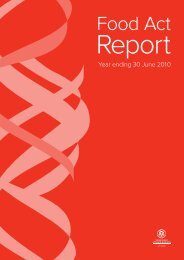Public Health and Communicable Diseases - SA Health - SA.Gov.au
Public Health and Communicable Diseases - SA Health - SA.Gov.au
Public Health and Communicable Diseases - SA Health - SA.Gov.au
You also want an ePaper? Increase the reach of your titles
YUMPU automatically turns print PDFs into web optimized ePapers that Google loves.
References1. Teutsch SM. Considerations in Planning a SurveillanceSystem. In: Teutsch SM, editor. Principles <strong>and</strong>Practice of <strong>Public</strong> <strong>Health</strong> Surveillance. New York:Oxford University Press; 1994.2. Miller M, et al. Australia’s notifiable disease status,2003 Annual report of the National Notifiable<strong>Diseases</strong> Surveillance System. <strong>Communicable</strong>Disease Intelligence. 2005;29(1):1-61.3. Hall G <strong>and</strong> Kirk M. Foodborne illness in Australia.National Centre for Epidemiology <strong>and</strong> Population<strong>Health</strong>. Canberra: OzFoodNet Working Group; 2005.4. Combs BG, R<strong>au</strong>pach JCA, Kirk M. Surveillanceof Shiga toxigenic Escherichia coli in Australia.<strong>Communicable</strong> Disease Intelligence. 2005;29(4):366-369.5. Cameron AS, et al. Community Outbreak of HemolyticUremic Syndrome Attributable to Escherichia coliO111:NM - South Australia, 1995. Morbidity <strong>and</strong>Mortality Weekly Report. 1995;44(29): 550-558.6. Department of <strong>Health</strong> <strong>and</strong> Ageing (DOHA).Surveillance systems reported in CDI, 2006.<strong>Communicable</strong> Disease Intelligence. 2006;30(1):156-160.7. Dicker RC. A brief review of the basic principles ofepidemiology. In: Gregg M, editor. Field Epidemiology.London: Oxford University Press; 2002.8. Hutwager LC, et al. Using Laboratory-BasedSurveillance Data for Prevention: An Algorithm forDetecting Salmonella Outbreaks. Emerging Infectious<strong>Diseases</strong>. 1997;3(3):395-400.Emerging communicablediseases: P<strong>and</strong>emic <strong>and</strong>Avian InfluenzaDr Ann KoehlerBSc, MBBS, FRCPA, MPHConsultant Microbiologist<strong>Communicable</strong> Disease Control BranchDepartment of <strong>Health</strong>A p<strong>and</strong>emic (from Greek pan all + demos people) isan epidemic (an outbreak of an infectious disease) thatspreads across a large region or worldwide.There are three types of influenza virus, A, B, <strong>and</strong> C.Influenza A c<strong>au</strong>ses much of the seasonal influenzaoutbreaks that occur annually, as well as less frequentp<strong>and</strong>emics. Influenza B <strong>and</strong> C are ‘human’ viruses thatare not found in avian hosts, though C viruses havebeen isolated from pigs <strong>and</strong> dogs. Neither types B norC c<strong>au</strong>se p<strong>and</strong>emics <strong>and</strong> both typically c<strong>au</strong>se milderrespiratory illness than influenza A.Influenza A is a zoonotic infection in humans. Its naturalhosts are wild aquatic birds, principally ducks, gulls,<strong>and</strong> waders, in whom it c<strong>au</strong>ses asymptomatic infectionof the gastrointestinal tract 1 . All of the subtypes ofinfluenza A (16 different neuraminidase types [N] <strong>and</strong>9 different haemagglutinin types [H]) can be isolatedfrom these birds. (Neuraminidase <strong>and</strong> haemagglutininare molecules on the surface of the virus involvedin attachment <strong>and</strong> release from host cells, <strong>and</strong> areimportant inducers of antibody response 2 .) They caninfect a wide range of birds <strong>and</strong> mammals, includingaquatic mammals such as whales. When a subtypechanges <strong>and</strong> is able to infect humans readily it maybecome established as a human influenza strain.The origins of recently circulating strains of influenzaA in humans can be traced back to p<strong>and</strong>emics of the20 th century – H1N1 from the 1918-19 ‘Spanish’ flup<strong>and</strong>emic, H2N2 from the 1957-58 Asian flu, <strong>and</strong> H3N2from the 1968-69 Hong Kong flu p<strong>and</strong>emic. Of the threeinfluenza p<strong>and</strong>emics last century, the 1918 p<strong>and</strong>emicwas the worst human disease outbreak ever recorded,c<strong>au</strong>sing acute illness in 30% of the world’s population,<strong>and</strong> killing up to 40 million people, more than thosekilled by the “Black Death”. The first recorded p<strong>and</strong>emicoccurred in 1580, though no doubt they occurred beforethis, <strong>and</strong> 31 have been documented since, most recentlyin 1968-69 3 . It is inevitable that another one will occur,<strong>and</strong> by historical measures it is overdue.Influenza p<strong>and</strong>emics occur when the influenza virusmutates to produce a virulent strain for humans to whichthe existing population has not been exposed. Influenza
















